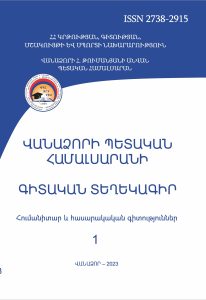The Study of the Features of the Most Usable Russian and English Phrases
Scientific Proceedings of Vanadzor State University Humanitarian and Social Sciences (ISSN 2738-2915)
2023 vol 1
The Study of the Features of the Most Usable Russian and English Phrases in the Armenian Classroom
Zhanna Aloyan
Nina Jaghinyan
Summary
 Key words: linguo-culture, methodological approach, interactive method of teaching, phraseological semantics, language environment, linguistic image of the world, set of meanings
Key words: linguo-culture, methodological approach, interactive method of teaching, phraseological semantics, language environment, linguistic image of the world, set of meanings
This given article is dedicated to the study analysis of Russian and English phrases from semantic and linguo-cultural perspectives. Through the methods of selection, description, coordination and comparison we’ve observed the semantics of the most usable Russian and English phrases and offered approaches for their study by the first-year students of the «English language and literature» Department. The article presents the most applied phrasal units, their general and specific features. We’ve analyzed a number of phrases, the meanings of which contain national-cultural components.
Having studied the subject matter in depth, we realized that phrases not only represent a linguistic means of expressing the concrete culture and national mentality, but also participate in the formation of the world perception of the given language – bearing people. The study of phrases of different languages necessarily reveals the very common thing that unites peoples, their national ideas, which is conditioned by the historical experience of a specific ethno-cultural community.
Having analyzed the whole material, we came to the conclusion that generalized knowledge about the language is a mandatory condition for universal knowledge, without which it’s quite impossible to study any language, especially in the case when there is no specific language environment.
The facts and linguistic structures presented in the article, in our deep conviction, can become a possible basis for the study of phraseological systems and units of different languages.
